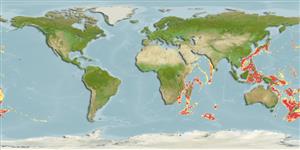Classification / Names
Common names from other countries
Main reference
Size / Weight / Age
Max length : 53.5 cm SL male/unsexed; (Ref. 43943)
Environment
Marine; bathydemersal; depth range 394 - 2365 m (Ref. 43943)
Climate / Range
Deep-water, preferred ?
Distribution
Short description
Head large; mouth subterminal. Eye diameter less than snout length. Opercular spine weak, broad, and flattened. Prominent cephalic sensory pores below eyes and on rear margin of preoperculum. Median basibranchial tooth patches 2. Vomer with V-shaped tooth patch. Anterior gill arch with 10-12 long rakers. Pectoral fins 12-15 rays, the longest about 1/2 or more in SL. Pelvic fins with 2 joined rays in each. Caudal fin rays 6. Branchiostegal rays 8. Precaudal vertebrae 15-16. Cycloid scales small, deciduous, covering head, body, and bases of dorsal, anal, and pectoral fins. Lateral line indistinct (Ref. 43943).
IUCN Red List Status (Ref. 115185)
Threat to humans
Harmless
Human uses
Fisheries: of no interest
More information
ReferencesAquacultureAquaculture profileStrainsGeneticsAllele frequenciesHeritabilityDiseasesProcessingMass conversion
Tools
Special reports
Download XML
Internet sources
Estimates of some properties based on models
Phylogenetic diversity index
PD50 = 1.0000 many relatives (e.g. carps) 0.5 - 2.0 few relatives (e.g. lungfishes)
Trophic Level
3.7 ±0.6 se; Based on size and trophs of closest relatives
Resilience
Medium, minimum population doubling time 1.4 - 4.4 years (Preliminary K or Fecundity.)
Vulnerability
Moderate to high vulnerability (51 of 100)
Price category
